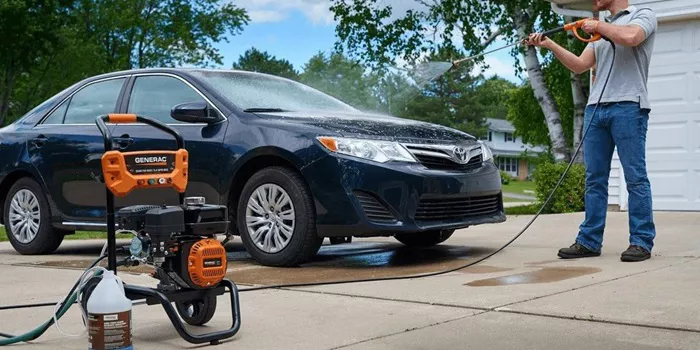Keeping your car clean is essential for both aesthetics and maintenance. Many car owners opt for pressure washers due to their effectiveness in removing dirt and grime. However, a common question arises: is it safe to use a pressure washer on a car? While pressure washers can provide excellent cleaning power, they can also cause damage if misused. This article will explore the benefits and risks of using a pressure washer on your car, along with essential safety guidelines to follow.
Understanding Pressure Washers
Pressure washers are machines that use high-pressure water streams to clean surfaces. They come in various models, with pressure levels measured in PSI (pounds per square inch). The pressure can range from around 1,300 PSI for light-duty cleaning to over 3,000 PSI for heavy-duty tasks. Understanding how pressure washers work and their capabilities is crucial before using one on your vehicle.
The Benefits of Using a Pressure Washer on Your Car
Effective Dirt Removal
One of the primary advantages of using a pressure washer is its ability to remove stubborn dirt and grime. Cars can collect various contaminants, including mud, dust, and bird droppings. A pressure washer’s high-pressure spray can tackle these issues effectively, making your car look cleaner in less time than traditional washing methods.
Saves Time and Effort
Washing a car with a traditional hose and sponge can be labor-intensive and time-consuming. A pressure washer allows you to clean large areas quickly, saving both time and effort. For individuals with busy schedules, this can be a significant benefit, allowing for more frequent cleanings without the hassle.
Water Efficiency
Pressure washers often use water more efficiently than traditional hoses. They release a controlled stream of water that can remove dirt effectively while using less water overall. This not only helps conserve water but can also lead to lower water bills.
The Risks of Using a Pressure Washer on Your Car
Potential Paint Damage
While pressure washers are effective, they can also pose risks to your car’s paint job. High pressure can strip paint or create chips, especially on older vehicles or those with pre-existing paint issues. The force of the water can be too intense, leading to damage that may require costly repairs.
Damage to Seals and Trim
Cars have various seals, such as those around windows and doors, designed to keep out water and debris. The high-pressure spray can dislodge or weaken these seals, leading to leaks and potential interior damage. This can compromise the integrity of your vehicle over time.
Risk of Scratches
Even though pressure washers are effective at removing dirt, they can also introduce new problems. If dirt particles are not adequately rinsed away before using the pressure washer, they can become abrasive. The high-pressure spray can push these particles into the paint, leading to scratches that can mar your car’s appearance.
How to Safely Use a Pressure Washer on Your Car
Choose the Right Pressure Setting
Selecting the correct pressure setting is crucial when washing your car. A PSI between 1,200 and 1,900 is generally safe for most vehicles. Using a pressure washer with a higher PSI can lead to damage, especially to the paint and delicate parts of your car.
Select the Appropriate Nozzle
Nozzles on pressure washers determine the width and intensity of the water spray. For cars, a nozzle with a wider spray angle, such as 25 degrees or 40 degrees, is recommended. These nozzles distribute the pressure more evenly and reduce the risk of damaging the paint. Avoid using a zero-degree nozzle, as it can concentrate the water force on a small area, leading to potential harm.
Maintain a Safe Distance
When using a pressure washer, always keep the nozzle at least 12 to 24 inches away from the car’s surface. This distance helps to prevent the concentrated spray from damaging the paint or pushing debris into the surface. A safe distance also allows the water pressure to dissipate before hitting the car.
Rinse Before Washing
Before applying soap, always start with a rinse to remove loose dirt and debris. This initial rinse can help minimize the risk of scratching the paint when you use the pressure washer later. A thorough rinse will also allow the soap to work more effectively.
see also: How to Wash Windows with a Power Washer
Best Practices for Pressure Washing Your Car
Use the Right Soap
Using the right cleaning solution is vital. Always choose a soap specifically designed for cars. Household cleaners can be too harsh and may damage the paint or clear coat. Using a foam cannon attachment with your pressure washer can help distribute the soap evenly.
Start at the Top and Work Downward
When washing your car, start at the roof and work your way down. This method allows dirt and grime to flow downward, preventing clean areas from becoming dirty again. A systematic approach ensures a thorough clean.
Dry the Car After Washing
After rinsing, it’s essential to dry your car immediately to prevent water spots from forming. Use a microfiber cloth or soft towel to wipe down the surfaces. This step is crucial, as water spots can leave unsightly marks on the paint and glass.
Conclusion
In summary, using a pressure washer on your car can be safe if done correctly. Understanding the right settings, selecting the appropriate nozzle, and following safe washing techniques are essential to prevent damage. Pressure washers offer a fast and effective way to clean your vehicle, but misuse can lead to costly repairs.
For those looking to maintain their car’s appearance and longevity, pressure washing can be an excellent option. By following the recommended guidelines, you can enjoy the benefits of a clean car without risking damage to its surface. Always remember that caution and proper technique are key to a successful car wash using a pressure washer.

